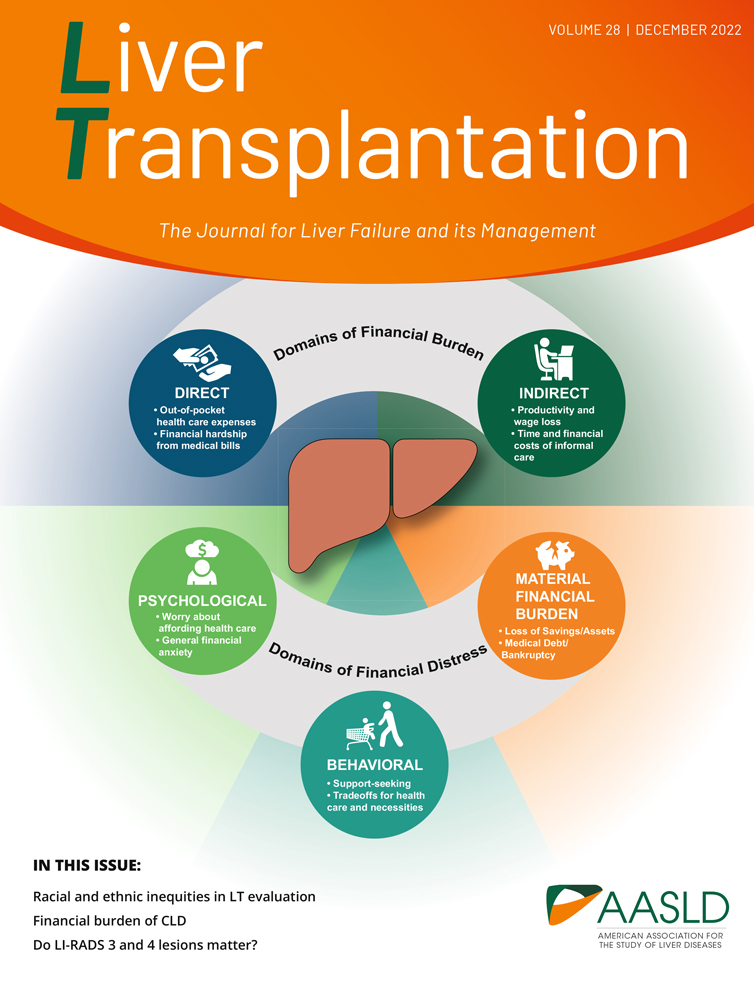Venoplasty of hepatic venous outflow with a venous patch in domino liver transplantation
DOMINO LIVER TRANSPLANTATION DONOR HEPATECTOMY
The domino donor (DD) was a 16-year-old boy with homozygous familial hypercholesterolemia. He received a whole liver graft from a 9-year-old deceased donor. We designed the hepatic outflow to be reconstructed by side-to-side cavocaval anastomosis for the first liver transplantation, so the DD hepatectomy was performed with preservation of the inferior vena cava (IVC) and the stumps of 3 hepatic veins were preserved as long as possible.
Abbreviations
DD, domino donor; IVC, inferior vena cava; LHV, left hepatic vein; MHV, middle hepatic vein; RHV, right hepatic vein.
BACK-TABLE PREPARATION OF THE DD LIVER GRAFT
At the back-table, the hepatic veins of the domino graft were jointed together easily (Fig. 1) by 6/0 prolene. A vein graft including the lower portion of the IVC in continuity with the left and right common iliac veins from the deceased donor was used. The graft was opened longitudinally to become a venous patch. One midline incision of the vein patch was done appropriately to be anastomosed with hepatic veins by 6/0 prolene sutures (Fig. 2). The external edge of the vein patch was further fashioned to be a wide cuff (Fig. 3).

The domino liver graft. The orifices of RHV, MHV, and LHV were jointed together by 6/0 prolene sutures. Abbreviations: LHV, left hepatic vein; MHV, middle hepatic vein; RHV, right hepatic vein.

The midline of the venous patch was incised appropriately to be anastomosed with hepatic veins by 6/0 prolene sutures. Abbreviations: LHV, left hepatic vein; MHV, middle hepatic vein; RHV, right hepatic vein.

The external edge of the vein patch was further fashioned to be a wide cuff. Abbreviations: LHV, left hepatic vein; MHV, middle hepatic vein; RHV, right hepatic vein.
SEQUENTIAL LIVER TRANSPLANTATION
The second recipient was a 59-year-old man with hepatitis B cirrhosis and hepatocellular carcinoma. The recipient's hepatectomy was performed with preservation of the IVC. The domino liver was implanted in the standard piggyback fashion by the suturing of the reconstructed suprahepatic venous cuff to the junction of all 3 hepatic veins of the recipient with clamping of the IVC but without venous-venous bypass.
RESULTS AND DISCUSSION
The cold ischemic time, warm ischemic time, and operative blood loss were 480 minutes, 34 minutes, and 450 cc, respectively, for the DD and 435 minutes, 38 minutes, and 3300 cc, respectively, for the second recipient. The DD was discharged on the 19th postoperative day with an uneventful recovery. The second recipient was discharged on the 12th postoperative day but was readmitted for anastomotic bile leakage 8 days after discharge. He was treated by a percutaneous transhepatic biliary stent and subsequently was well with normal liver functions. The Doppler ultrasound showed normal triphasic flow into all major hepatic veins of the domino liver 6 weeks after transplantation.
There have been a few reports regarding the techniques of outflow reconstruction for conditions similar to our case.1-4 Our case followed the technique described by Cescon et al.,4 and the successful outcome reassures us of the usefulness of this technique. In addition, we suggest side-to-side caval anastomosis5 for the first whole liver implantation in order to retrieve longer stumps of hepatic veins of the domino liver. The long stumps of hepatic veins are easily jointed together, and this in turn makes the vein-patch technique for outflow reconstruction of the domino liver graft easier.




